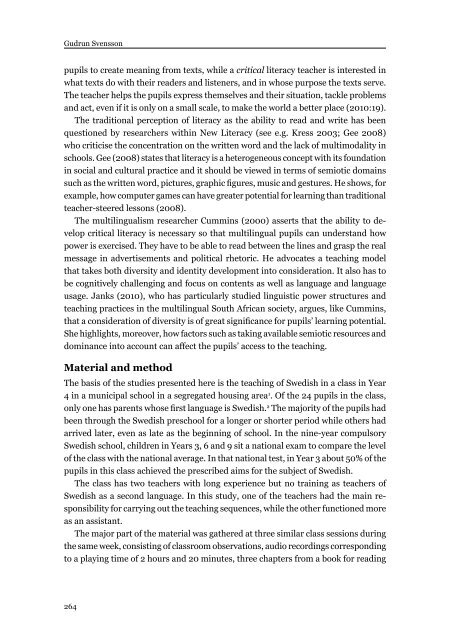Download issue - Umeå universitet
Download issue - Umeå universitet
Download issue - Umeå universitet
You also want an ePaper? Increase the reach of your titles
YUMPU automatically turns print PDFs into web optimized ePapers that Google loves.
Gudrun Svensson<br />
pupils to create meaning from texts, while a critical literacy teacher is interested in<br />
what texts do with their readers and listeners, and in whose purpose the texts serve.<br />
The teacher helps the pupils express themselves and their situation, tackle problems<br />
and act, even if it is only on a small scale, to make the world a better place (2010:19).<br />
The traditional perception of literacy as the ability to read and write has been<br />
questioned by researchers within New Literacy (see e.g. Kress 2003; Gee 2008)<br />
who criticise the concentration on the written word and the lack of multimodality in<br />
schools. Gee (2008) states that literacy is a heterogeneous concept with its foundation<br />
in social and cultural practice and it should be viewed in terms of semiotic domains<br />
such as the written word, pictures, graphic figures, music and gestures. He shows, for<br />
example, how computer games can have greater potential for learning than traditional<br />
teacher-steered lessons (2008).<br />
The multilingualism researcher Cummins (2000) asserts that the ability to develop<br />
critical literacy is necessary so that multilingual pupils can understand how<br />
power is exercised. They have to be able to read between the lines and grasp the real<br />
message in advertisements and political rhetoric. He advocates a teaching model<br />
that takes both diversity and identity development into consideration. It also has to<br />
be cognitively challenging and focus on contents as well as language and language<br />
usage. Janks (2010), who has particularly studied linguistic power structures and<br />
teaching practices in the multilingual South African society, argues, like Cummins,<br />
that a consideration of diversity is of great significance for pupils’ learning potential.<br />
She highlights, moreover, how factors such as taking available semiotic resources and<br />
dominance into account can affect the pupils’ access to the teaching.<br />
Material and method<br />
The basis of the studies presented here is the teaching of Swedish in a class in Year<br />
4 in a municipal school in a segregated housing area 1 . Of the 24 pupils in the class,<br />
only one has parents whose first language is Swedish. 2 The majority of the pupils had<br />
been through the Swedish preschool for a longer or shorter period while others had<br />
arrived later, even as late as the beginning of school. In the nine-year compulsory<br />
Swedish school, children in Years 3, 6 and 9 sit a national exam to compare the level<br />
of the class with the national average. In that national test, in Year 3 about 50% of the<br />
pupils in this class achieved the prescribed aims for the subject of Swedish.<br />
The class has two teachers with long experience but no training as teachers of<br />
Swedish as a second language. In this study, one of the teachers had the main responsibility<br />
for carrying out the teaching sequences, while the other functioned more<br />
as an assistant.<br />
The major part of the material was gathered at three similar class sessions during<br />
the same week, consisting of classroom observations, audio recordings corresponding<br />
to a playing time of 2 hours and 20 minutes, three chapters from a book for reading<br />
264

















